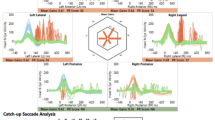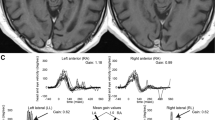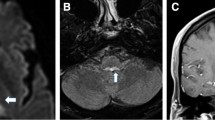Abstract
Purpose
The first aim of this review is to summarize recent ocular motor signs in pre-encephalopathy patients with nutritional deficiency at risk of thiamine deficiency. Timely recognition of thiamine depletion in these patients, who may have a normal brain MRI, could lead to appropriate management and prevention of Wernicke’s encephalopathy (WE) with full recovery. The second aim is to incorporate recent diagnostic testing on the revised WE diagnostic criteria and the identification of patients who may show slow, partial, or no response to treatment.
Recent Findings
Selective vulnerability of periventricular gray neurons in thiamine deficiency is well known. Involvement of the vestibular and abducens nuclei may precede encephalopathy. Studies have shown mild ophthalmoparesis and bilateral symmetric vestibular loss in thiamine deficiency. Moreover, quantitative data has shown decreased horizontal vestibulo-ocular reflex (VOR) gain and nystagmus, with a favorable response to timely treatment.
Summary
Ophthalmoparesis, horizontal nystagmus, and decreased gain of the horizontal VOR, sparing the vertical VOR, may be present in the early pre-encephalopathy stage of thiamine deficiency. Rapid response to a loading dose of parenteral thiamine might be seen in some cases and normalization, albeit slower in others. In contrast, analogous to the Korsakoff’s syndrome, ocular motor and vestibular abnormalities may show only partial improvement. Future studies in larger populations at risk are needed to confirm the results of these preliminary observations.


Similar content being viewed by others
References
Papers of particular interest, published recently, have been highlighted as: • Of importance
Victor MARD, Collins GH. Wernicke Korsakoff's syndrome. Philadelphia: F. A. Davis; 1971.
Halmagyi GM, Curthoys IS. A clinical sign of canal paresis. Arch Neurol. 1988;45:737–9.
Weber KP, MacDougall HG, Halmagyi GM, Curthoys IS. Impulsive testing of semicircular-canal function using video-oculography. Ann N Y Acad Sci. 2009;1164:486–91.
Mac Dougall HGMGL, Halmagyi MG, Curthoys IS, Weber KP. The video head impulse test (vHIT) detects vertical semicricular canal function. PLoS One. 2013;8:1–10.
Mancinelli R, Ceccanti M, Guiducci MS, et al. Simultaneous liquid chromatographic assessment of thiamine, thiamine monophosphate and thiamine diphosphate in human erythrocytes: a study on alcoholics. J Chromatogr B Anal Technol Biomed Life Sci. 2003;789:355–63.
Rugilo CA, Uribe Roca MC, Zurru MC, Capizzano AA, Pontello GA, Gatto EM, Proton MR. Spectroscopy in Wernicke encephalopathy. AJNR Am J Neuroradiol. 2003;24:952–5.
Weidauer S, Nichtweiss M, Lanfermann H, Zanella FE. Wernicke encephalopathy: MR findings and clinical presentation. Eur Radiol. 2003;13:1001–9.
Chung SP, Kim SW, Yoo IS, Lim YS, Lee G. Magnetic resonance imaging as a diagnostic adjunct to Wernicke encephalopathy in the ED. Am J Emerg Med. 2003;21:497–502.
Zuccoli G, Pipitone N. Neuroimaging findings in acute Wernicke’s encephalopathy: review of the literature. AJR Am J Roentgenol. 2009;192:501–8.
• Kattah JCDS, Pula JH, Mantokoudis G, Therani AS, Newman Toker DE. Vestibular signs in non-encephalopathic Wernicke’s disease. Neurol Clin Practice. 2013;3:460–7. This article describes the vHIT in the diagnosis of thiamine deficiency
Caine D, Halliday GM, Kril JJ, Harper CG. Operational criteria for the classification of chronic alcoholics: identification of Wernicke’s encephalopathy. J Neurol Neurosurg Psychiatry. 1997;62:51–60.
• Galvin R, Brathen G, Ivashynka A, et al. EFNS guidelines for diagnosis, therapy and prevention of Wernicke encephalopathy. Eur J Neurol. 2010;17:1408–18. This article proposes new Wernicke’s Encephalopathy Diagnostic Criteria
• Choi KD, Oh SY, Kim HJ, Kim JS. The vestibulo-ocular reflexes during head impulse in Wernicke's encephalopathy. J Neurol Neurosurg Psychiatry. 2007;78:1161–2. This article describes the vHIT in the diagnosis of thiamine deficiency
• Sechi G, Serra A. Wernicke’s encephalopathy: new clinical settings and recent advances in diagnosis and management. The Lancet Neurology. 2007;6:442–55. This article is an excellent review of diagnosis and treatment of thiamine deficiency and Wernicke’s Encephalopathy
Harper C. Wernicke’s encephalopathy: a more common disease than realised. A neuropathological study of 51 cases. J Neurol Neurosurg Psychiatry. 1979;42:226–31.
Harper C. The incidence of Wernicke’s encephalopathy in Australia—a neuropathological study of 131 cases. J Neurol Neurosurg Psychiatry. 1983;46:593–8.
Harper CG, Giles M, Finlay-Jones R. Clinical signs in the Wernicke-Korsakoff complex: a retrospective analysis of 131 cases diagnosed at necropsy. J Neurol Neurosurg Psychiatry. 1986;49:341–5.
Harper C, Gold J, Rodriguez M, Perdices M. The prevalence of the Wernicke-Korsakoff syndrome in Sydney, Australia: a prospective necropsy study. J Neurol Neurosurg Psychiatry. 1989;52:282–5.
Cogan DG, Witt ED, Goldman-Rakic PS. Ocular signs in thiamine-deficient monkeys and in Wernicke’s disease in humans. Arch Ophthalmol. 1985;103:1212–20.
Cogan DG, Victor M. Ocular signs of Wernicke’s disease. AMA archives of ophthalmology. 1954;51:204–11.
Kim K, Shin DH, Lee YB, et al. Evolution of abnormal eye movements in Wernicke’s encephalopathy: correlation with serial MRI findings. J Neurol Sci. 2012;323:77–9.
De La Paz MA, Chung SM, McCrary III JA. Bilateral internuclear ophthalmoplegia in a patient with Wernicke’s encephalopathy. Journal of clinical neuro-ophthalmology. 1992;12:116–20.
Kenyon RV, Becker JT, Butters N, Hermann H. Oculomotor function in Wernicke-Korsakoff's syndrome: I. Saccadic eye movements. The International journal of neuroscience. 1984;25:53–65.
Kenyon RV, Becker JT, Butters N. Oculomotor function in Wernicke-Korsakoff’s syndrome: II. Smooth pursuit eye movements. The International journal of neuroscience. 1984;25:67–79.
Cox TA, Corbett JJ, Thompson HS, Lennarson L. Upbeat nystagmus changing to downbeat nystagmus with convergence. Neurology. 1981;31:891–2.
Furman JM, Becker JT. Vestibular responses in Wernicke’s encephalopathy. Ann Neurol. 1989;26:669–74.
Sakuma A, Kato I, Ogino S, Okada T, Takeyama I. Primary position upbeat nystagmus with special reference to alteration to downbeat nystagmus. Acta Otolaryngol Suppl. 1996;522:43–6.
Kastrup O, Maschke M, Keidel M, Diener HC. Presumed pharmacologically induced change from upbeat- to downbeat nystagmus in a patient with Wernicke’s encephalopathy. Clin Neurol Neurosurg. 2004;107:70–2.
Suzuki Y, Matsuda T, Washio N, Ohtsuka K. Transition from upbeat to downbeat nystagmus observed in a patient with Wernicke’s encephalopathy. Jpn J Ophthalmol. 2005;49:220–2.
• Shin BS, Oh SY, Kim JS, Lee H, Kim EJ, Hwang SB. Upbeat nystagmus changes to downbeat nystagmus with upward gaze in a patient with Wernicke’s encephalopathy. J Neurol Sci. 2010;298:145–7. This article describes the transition from upbeat to downbeat nystagmus in thiamine deficiency
Abouaf L, Vighetto A, Magnin E, Nove-Josserand A, Mouton S, Tilikete C. Primary position upbeat nystagmus in Wernicke’s encephalopathy. Eur Neurol. 2011;65:160–3.
Ghez C. Vestibular paresis: a clinical feature of Wernicke’s disease. J Neurol Neurosurg Psychiatry. 1969;32:134–9.
• Akdal G, MacDougall HG, Chen L, Tanriverdizade T, Yigitaslan O, Halmagyi GM. Selective impairment of horizontal vestibulo-ocular reflexes in acute Wernicke’s encephalopathy. J Neurol Sci. 2016;365:167–8. This article describes the vHIT in the diagnosis of thiamine deficiency
Zuccoli G, Siddiqui N, Rizzi R, Marcello N. Neurological picture. Pendular nystagmus showing involvement of the floccular lobes in an atypical case of Wernicke encephalopathy: MRI findings. J Neurol Neurosurg Psychiatry. 2010;81:858.
Campbell ACP. RWR. Wernicke’s encephalopaty. The clinical features and their probable relationship to vitamin B deficiency. Qaut J Med. 1941;10:41–64.
Witt ED. Neuroanatomical consequences of thiamine deficiency: a comparative analysis. Alcohol Alcohol. 1985;20:201–21.
Schabelman E, Kuo D. Glucose before thiamine for Wernicke encephalopathy: a literature review. The Journal of emergency medicine. 2012;42:488–94.
Thomson AD, Cook CC, Touquet R, Henry JA, Royal College of Physicians L. The Royal College of Physicians report on alcohol: guidelines for managing Wernicke’s encephalopathy in the accident and emergency department. Alcohol Alcohol. 2002;37:513–21.
Author information
Authors and Affiliations
Corresponding author
Ethics declarations
Conflict of Interest
GN Otometrics based in Schaumburg, Illinois, loaned Jorge C. Kattah equipment to perform the video head impulse test.
Human and Animal Rights and Informed Consent
This article does not contain any studies with human or animal subjects performed by any of the authors.
Additional information
This article is part of the Topical Collection on Neuro-Ophthalmology
Electronic supplementary material
Rights and permissions
About this article
Cite this article
Kattah, J.C. The Spectrum of Vestibular and Ocular Motor Abnormalities in Thiamine Deficiency. Curr Neurol Neurosci Rep 17, 40 (2017). https://doi.org/10.1007/s11910-017-0747-9
Published:
DOI: https://doi.org/10.1007/s11910-017-0747-9




